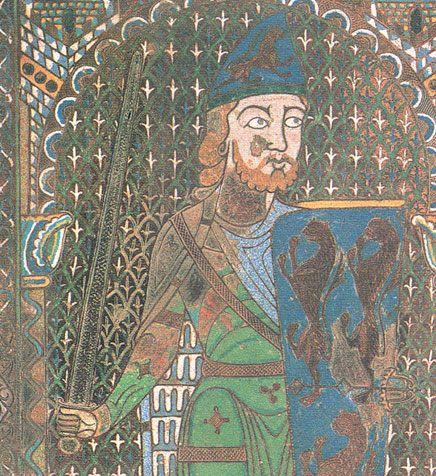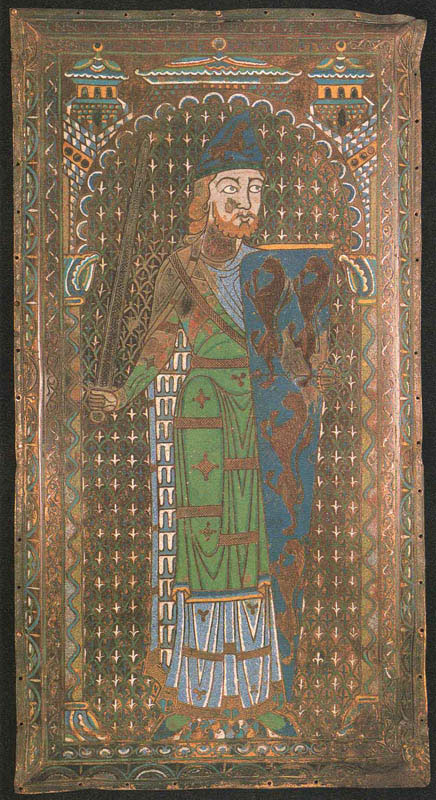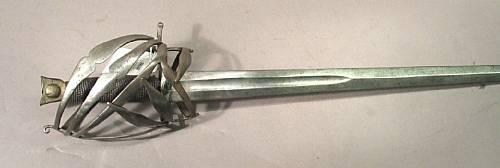| Author |
Message |
Michal Plezia
Industry Professional

|
 Posted: Wed 17 Dec, 2008 8:55 am Post subject: pattern welding in late medieval Europe? Posted: Wed 17 Dec, 2008 8:55 am Post subject: pattern welding in late medieval Europe? |
 |
|
Hello
I have a question about pattern welding.We all know that this technique was popular in early medieval times.Than better quality steel allowed to produce decent weapons cheaper and faster without it.
I remember Peter Johnsson said something like that(but my memory may be wrong): bladesmiths still were useing pattern welding in later times, but not in combat weapons, but for decorative, hunting etc. pieces.
Are there any examples of pattern welded european weapons from 13-15 century ?
www.elchon.com
Polish Guild of Knifemakers
The sword is a weapon for killing, the art of the sword is the art of killing. No matter what fancy words you use or what titles you put to
it that is the only truth.
|
|
   |
 |
|
Gary Teuscher
|
 Posted: Wed 17 Dec, 2008 9:01 am Post subject: Posted: Wed 17 Dec, 2008 9:01 am Post subject: |
 |
|
|
No specifics, but I have heard pattern welding remained in use at least somewhat in Scandanavian countries during this time.
|
|
  |
 |
Michal Plezia
Industry Professional

|
 Posted: Fri 19 Dec, 2008 7:36 am Post subject: Posted: Fri 19 Dec, 2008 7:36 am Post subject: |
 |
|
Thee is an information in 'Knives and Scabbards' about possible patern welded knife from the late 14c. (page 16)
www.elchon.com
Polish Guild of Knifemakers
The sword is a weapon for killing, the art of the sword is the art of killing. No matter what fancy words you use or what titles you put to
it that is the only truth.
|
|
   |
 |
|
Vaclav Homan
Location: Hradec, Czech Joined: 22 Jan 2008
Posts: 90
|
 Posted: Fri 19 Dec, 2008 11:23 am Post subject: Posted: Fri 19 Dec, 2008 11:23 am Post subject: |
 |
|
You are right this technology was marginal after 12 century. But in Russia was used until 15 century.
This matter you can better study in polish books (Piaskovsky) or Kolocin, Pleiner.
There is only one art of fence yet many ways to reach it
|
|
  |
 |
Michal Plezia
Industry Professional

|
 Posted: Sat 20 Dec, 2008 11:00 am Post subject: Posted: Sat 20 Dec, 2008 11:00 am Post subject: |
 |
|
Any pictures of known after 13century examples?I couldn't find any in the internet nor in my books...
www.elchon.com
Polish Guild of Knifemakers
The sword is a weapon for killing, the art of the sword is the art of killing. No matter what fancy words you use or what titles you put to
it that is the only truth.
|
|
   |
 |
|
Peter Johnsson
Industry Professional
|
 Posted: Sat 20 Dec, 2008 12:02 pm Post subject: Posted: Sat 20 Dec, 2008 12:02 pm Post subject: |
 |
|
|
The only cases I know of pattern welding being used in a high medieval context (in wester europe) is in some knives. You will find a few illustrated in "Knives and Scabbards , medieval finds from excavations i London".
|
|
   |
 |
Michal Plezia
Industry Professional

|
 Posted: Sun 21 Dec, 2008 5:19 am Post subject: Posted: Sun 21 Dec, 2008 5:19 am Post subject: |
 |
|
Thanks Peter.Those examples I know.
But what about central and eastern Europe? What about the Byzantine Empire?
Gary Teuscher mentioned Scandinavia.They had strong tradition in pattern welding indeed.Did they let it disappear?
www.elchon.com
Polish Guild of Knifemakers
The sword is a weapon for killing, the art of the sword is the art of killing. No matter what fancy words you use or what titles you put to
it that is the only truth.
|
|
   |
 |
|
Peter Johnsson
Industry Professional
|
 Posted: Sun 21 Dec, 2008 6:12 am Post subject: Posted: Sun 21 Dec, 2008 6:12 am Post subject: |
 |
|
| Michal Plezia wrote: | Thanks Peter.Those examples I know.
But what about central and eastern Europe? What about the Byzantine Empire?
Gary Teuscher mentioned Scandinavia.They had strong tradition in pattern welding indeed.Did they let it disappear? |
As Vaclav Homan wrote earlier in the thread you see pattern welding surviving in the east. I do not know how far west this tradition stretches. It is note worthy that this is an area where completely different swords were popular, even if some types do overlap. It is a different tradition and so we see a different development of manufacturing techniques.
Central and Western europe has another tradition in arms manufacture. In fact the same centers of production delivered the same products east, west, north and south. Or at least had great influence on fringe craftsmen, one might assume.
Where you might find pattern welding is in such objects as were made locally. Mostly "simpler" objects, that is: fancy knives perhaps. It is rare, but once in a while you do come across the odd pattern welded knife blade from a much later period.
I have not seen any signs that pattern welding should have survived any longer into high medieval period in Scandinavia. During the viking period it seems to die out, surviving longest in the odd spear heads for example.
I am not even sure the pattern welding tradition was any more developed or advanced in scandinavia, than in other parts of europe during its period of use.
There might be others around who has studied this more than I have. I have just not run across examples of pattern welding from later time periods in museum store rooms. It was a good way to do things (form many obvious as well as obscure reasons) during a period of time. Times changed and made the process obsolete. It might not even have been practical or functional reasons. It could have been economical, or political reasons. There is much that can change the way we do things.
|
|
   |
 |
Michal Plezia
Industry Professional

|
 Posted: Tue 23 Dec, 2008 8:08 am Post subject: Posted: Tue 23 Dec, 2008 8:08 am Post subject: |
 |
|
http://gladius.revistas.csic.es/index.php/gla...le/146/146 here is an interesting article.
There is an info about six knives from Poland described by Piaskowski "five of which had laminated bodies of alternating stripes of low and high-carbon iron and all with a high carbon cutting edge" (page 2)
I'll try to find that book of Piaskowski.
www.elchon.com
Polish Guild of Knifemakers
The sword is a weapon for killing, the art of the sword is the art of killing. No matter what fancy words you use or what titles you put to
it that is the only truth.
|
|
   |
 |
Michael Harley

Location: Melbourne, Australia Joined: 12 Apr 2006
Posts: 94
|
 Posted: Thu 25 Dec, 2008 12:58 am Post subject: Posted: Thu 25 Dec, 2008 12:58 am Post subject: |
 |
|
I know it's not quite 13th.C., but it's such a beautiful depiction, I just had to share.
From the tomb of Geoffrey Plantagenet d.1151.
Cheers,
Michael.
 Attachment: 113.55 KB Attachment: 113.55 KB

 Attachment: 124.63 KB Attachment: 124.63 KB

|
|
   |
 |
Jared Smith

|
 Posted: Thu 25 Dec, 2008 10:05 am Post subject: Posted: Thu 25 Dec, 2008 10:05 am Post subject: |
 |
|
I briefly looked around, unsuccessfully, to find a paper I had read a few years ago. I think is was Verhoeven that surveyed pattern welded swords from collections and concluded that the tradition sort of faded out around 11th to 14th century. That said, there was still a percentage (decaying rapidly to less than 25%) of swords with X-ray evidence of pattern welded structure. Some late swords have been speculated may have originally been pattern welded. i.e. the 15th century era sword of Joan of Arc was said to have four stars patterned in the metal of the blade. We don't know with certain providence that any present day surviving sword actually was that sword. But, a theory that it was originally a pattern welded blade sounds plausible.
Absence of evidence is not necessarily evidence of absence!
|
|
  |
 |
|
Zach Gordon
|
 Posted: Thu 25 Dec, 2008 3:37 pm Post subject: Posted: Thu 25 Dec, 2008 3:37 pm Post subject: |
 |
|
|
Some blades were re-made like there is a 16th(?) cent. katzbalger w/ a pattern-welded pre-1000 viking blade. some would be rehilted for years to come and some cut down and re-forged into knives
|
|
  |
 |
|
Jeff Pringle
Industry Professional
Location: Oakland, CA Joined: 19 Nov 2005
Posts: 145
|
 Posted: Fri 26 Dec, 2008 6:40 am Post subject: Posted: Fri 26 Dec, 2008 6:40 am Post subject: |
 |
|
A little late, but this 18th century Venetian schiavona recently at auction had a PW’d blade, not visible in the photo but in person you could see it was layered metal that had been manipulated by the smith.
 Attachment: 10.9 KB Attachment: 10.9 KB

|
|
  |
 |
Bruno Giordan

|
 Posted: Fri 26 Dec, 2008 10:41 am Post subject: Posted: Fri 26 Dec, 2008 10:41 am Post subject: |
 |
|
| Jeff Pringle wrote: | | A little late, but this 18th century Venetian schiavona recently at auction had a PW’d blade, not visible in the photo but in person you could see it was layered metal that had been manipulated by the smith. |
Our blades had piled construction, sometimes piled and twisted (foglia system). It was made by using different layers of the same metal, so it cannot be called pattern welding. This system was in use until recently, it seems.
There is a nice work by Milan Polytechnic school on a sword from the riverbed of the river Adige, a XIIth century blade which had been dredged up as a poor stump, just one third being surviving, so that last year it was cut into slices : analysis showed eight layers welded in a piled structure, then carburized.
|
|
  |
 |
|
|

